HP LP3065: A new contender for the 30" throne
by Jarred Walton on March 22, 2007 7:00 AM EST- Posted in
- Displays
Appearance and Design
The overall appearance and design of the LP3065 is similar to what we find with most other 30" LCDs - Apple's Cinema Display being the exception. You get a very large LCD panel with a base stand that supports swivel, tilt, and height adjustment. Rotate/auto rotate are not supported, which is typical of larger LCDs.
The case exterior is an industrial black plastic, which ostensibly helps make the display more useful in multi-display environments. Besides, but is generally a neutral coloring for computer parts, and we think the display looks at least as good as any of the other LCDs we've used, from a purely aesthetic viewpoint. The side bezels are reasonably narrow, so if you're interested in setting up a massive multi-display work area (and you have the funds to support it) all you really need is a computer system capable of driving two dual-link outputs.
As usual, there's not much to see on the rear of the unit, other than the VESA wall mount and model information/serial number. The input and power connections face the floor, but thanks to the height adjustment and a generous amount of tilt they are reasonably easy to access even after the display has been set up. The base stand feels quite sturdy, which you would expect of something designed to hold a 20+ pound panel. The panel locks into place when you slide it onto the base stand, and in order to remove the panel you have to push the release lever to the left or right. You can also tighten a hex nut to prevent the lever from being moved, effectively locking the panel into place.
Here's another shot of the rear of the unit without the base stand installed. At the top of the display, there's also a pseudo-handle that can be useful when moving the panel around.
Here you can see the left side of the panel showing the tilt mechanism in full swing, ranging from a 5° forward tilt to a 30° backwards tilt. You can also see the four USB ports.
The major difference between the HP LP3065 on the other 30" LCDs on the market is, as previously mentioned, the number of input ports. For most others only include a single dual-link DVI port, HP includes three along with a mechanism to easily select between them.
In terms of controls, there are four buttons on the front of the panel: input select, decrease/increase brightness, and the power button. There is no on-screen display, which is typical of 30" LCDs. We would really like to see a 30" LCD that offered additional inputs (for example, component and VGA support up to 1920x1200 would be great), and the lack of an OSD has also puzzled us. The reason these features are provided is quite simple: there is at present no IC solution that provides for an OSD on 2560x1600 LCDs. That also explains why the single-link mode only functions that one fourth of the native resolution, because all scaling is handled by your graphics card and not by the LCD circuitry.
We have been told that an IC solution is in the works, and it is very likely that we will see future 30" LCDs that support on on-screen display and additional input options, as well as the ability to natively control image scaling. As the majority of people will prefer to run any LCD at its native resolution, such concerns are secondary. Still, it does prevent the 30" LCDs from being able to provide true multifunction support, which is a shame considering a 30" LCD could easily work as an HDTV.
We look forward to seeing future 30" LCDs (and perhaps even larger models) that are capable of supporting additional inputs. Considering the price and the dual-link requirement, we still feel that 24" LCDs are a better choice for most high-end users, and the 19"-22" offerings are great for the midrange and mainstream markets. Even entry level systems generally use 19" LCDs these days, with prices that are only moderately more expensive than the old 17" CRTs. If you are in the market for 30" LCD, however, the HP LP3065 is definitely at the top of the features charts right now.
The overall appearance and design of the LP3065 is similar to what we find with most other 30" LCDs - Apple's Cinema Display being the exception. You get a very large LCD panel with a base stand that supports swivel, tilt, and height adjustment. Rotate/auto rotate are not supported, which is typical of larger LCDs.
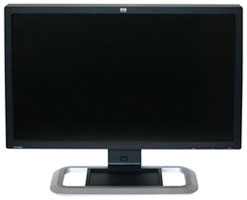 |
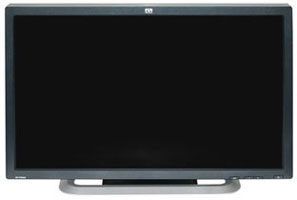 |
| Click to enlarge | |
The case exterior is an industrial black plastic, which ostensibly helps make the display more useful in multi-display environments. Besides, but is generally a neutral coloring for computer parts, and we think the display looks at least as good as any of the other LCDs we've used, from a purely aesthetic viewpoint. The side bezels are reasonably narrow, so if you're interested in setting up a massive multi-display work area (and you have the funds to support it) all you really need is a computer system capable of driving two dual-link outputs.
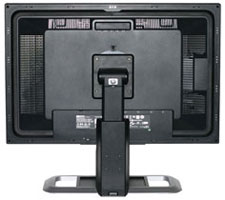 |
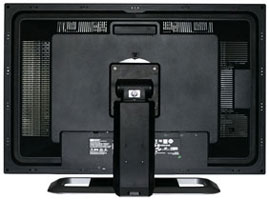 |
| Click to enlarge | |
As usual, there's not much to see on the rear of the unit, other than the VESA wall mount and model information/serial number. The input and power connections face the floor, but thanks to the height adjustment and a generous amount of tilt they are reasonably easy to access even after the display has been set up. The base stand feels quite sturdy, which you would expect of something designed to hold a 20+ pound panel. The panel locks into place when you slide it onto the base stand, and in order to remove the panel you have to push the release lever to the left or right. You can also tighten a hex nut to prevent the lever from being moved, effectively locking the panel into place.
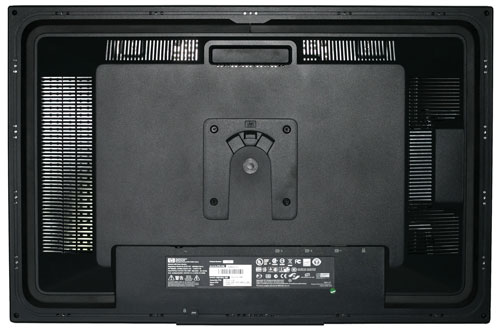 |
| Click to enlarge |
Here's another shot of the rear of the unit without the base stand installed. At the top of the display, there's also a pseudo-handle that can be useful when moving the panel around.
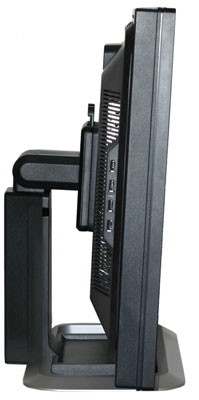 |
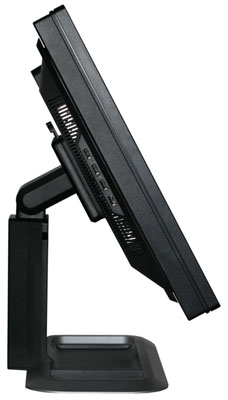 |
| Click to enlarge | |
Here you can see the left side of the panel showing the tilt mechanism in full swing, ranging from a 5° forward tilt to a 30° backwards tilt. You can also see the four USB ports.
 |
| Click to enlarge |
The major difference between the HP LP3065 on the other 30" LCDs on the market is, as previously mentioned, the number of input ports. For most others only include a single dual-link DVI port, HP includes three along with a mechanism to easily select between them.
In terms of controls, there are four buttons on the front of the panel: input select, decrease/increase brightness, and the power button. There is no on-screen display, which is typical of 30" LCDs. We would really like to see a 30" LCD that offered additional inputs (for example, component and VGA support up to 1920x1200 would be great), and the lack of an OSD has also puzzled us. The reason these features are provided is quite simple: there is at present no IC solution that provides for an OSD on 2560x1600 LCDs. That also explains why the single-link mode only functions that one fourth of the native resolution, because all scaling is handled by your graphics card and not by the LCD circuitry.
We have been told that an IC solution is in the works, and it is very likely that we will see future 30" LCDs that support on on-screen display and additional input options, as well as the ability to natively control image scaling. As the majority of people will prefer to run any LCD at its native resolution, such concerns are secondary. Still, it does prevent the 30" LCDs from being able to provide true multifunction support, which is a shame considering a 30" LCD could easily work as an HDTV.
We look forward to seeing future 30" LCDs (and perhaps even larger models) that are capable of supporting additional inputs. Considering the price and the dual-link requirement, we still feel that 24" LCDs are a better choice for most high-end users, and the 19"-22" offerings are great for the midrange and mainstream markets. Even entry level systems generally use 19" LCDs these days, with prices that are only moderately more expensive than the old 17" CRTs. If you are in the market for 30" LCD, however, the HP LP3065 is definitely at the top of the features charts right now.










44 Comments
View All Comments
JarredWalton - Thursday, March 22, 2007 - link
I tried to get one and Apple declined. I think Anand has their original version, but that has been outdated by newer releases. If Apple updates their 30" display again, I will see if they're interested in sending one for review.FXi - Thursday, March 22, 2007 - link
The brightness is too low. And the benefit (the wider gamut) is harder to gain the advantage of visually than losing the brightness. In fact it is likely the older 3007FP is a better screen in practical use than the 3007FPHC.I'm not talking TV levels here like 500-550 cd/m2, but rather that 400-450 wasn't bad, and as the backlights degrade slowly over time, effectively give a nice lifespan if you aren't using them in bright environments.
The cost of adding a few extra DVI-D inputs is so cheap it's a travesty they weren't included in every 30" model. PIP might be genuinely useful on a screen this size, so there's another area where the scaling and picture circuitry would be useful. In fact, skip the USB bus entirely and at least give me two, or three DVI-D ports instead.
Probably I missed how you approached it but I saw no direct mention of screen uniformity, which has been a bother in earlier 30" models.
I would add the Samsung 305T and XL30 (when it arrives) to show the full gamut of these size screens. A LOT of folks are commenting that the increased color gamut isn't all that noticeable or useful due partially to a lack of good standards on the pc side to utilize that gamut. 120hz is going to happen faster to smaller displays (sorry) because a DVI-D might have enough bandwidth to drive lower res at double the refresh. I'm not perfectly familiary with the overhead needs, but the bandwidth will be there first, not first in larger displays and moving down. This again points to the use of a 32" 1080P 120hz screen utilizing a card that had HDMI 1.3 output as your fastest way of getting to the 120hz goodness if that is what you seek. Otherwise you'll have to wait a few years.
Core things that need to happen to 30" in general:
400-450 brightness
OSD's
Scaling chips and alternate/multiple inputs
LED backlights (as practical - and not for the gamut increased but the better contrast ratio, screen uniformity and lifespan)
Faster and more consistent (better profiled acceleration) TrTf and GtG speeds
Color accuracy and grey accuracy put ahead of gamut changes. Meaning gamut is useful to a small degree, but the end user is going to appreciate careful color filters and lcd pixel (gray) accuracy more than just increased gamut.
Loved reading these article, because you don't just cover the 30's or the newest 2407 but also the older models, so people can see if the "switch up" is worth the $$.
Thanks!
AnnonymousCoward - Thursday, March 22, 2007 - link
Thanks so much for the review. But I gotta give criticism on the timing, since this is perhaps the best computer display ever, and you waited over 4 months after it came out to review it. Yet when it comes to video cards or CPUs, you review them immediately, sometimes before they're even released! A display is equally important to those components.JarredWalton - Thursday, March 22, 2007 - link
If you look at our display reviews, you'll notice that we only recently started doing these again. The first recent display review was in late February, and since then we've been trying to grow the display reviews section aggressively. Hopefully we will get future displays around launch time, now that we're recommitted to the section. Not surprisingly, HP wasn't really pushing to get us a 30" LCD for a launch-date review when we hadn't covered any LCDs recently. :)chakarov - Friday, March 23, 2007 - link
In your review you say that there isn't much difference between HP's LP3065 and old Dell 3007 WFP. While this would be very informative for some people a few weeks ago now this information is of no value any more because now Dell is selling only their new model 3007 WFP-HC which is comparative in price to LP3065.Now people should decide between support, design, one or three DVI connectors and price.
JarredWalton - Saturday, March 24, 2007 - link
I thought that was the point I made (second paragraph, page 2) - that the new 3007WFP-HC is basically the same panel as the HP model. It's also why I recommend the HP over the Dell, as the multiple inputs seems like a lot more value added than a flash reader, and the price is now the same. (If you can find the older 3007WFP for less money, that's definitely a good choice as well!)AnnonymousCoward - Saturday, March 24, 2007 - link
chakarov's point is that the late-ness of this review is especially critical because there's apparently not much difference between the LP3065 ($1700) and the original 3007WFP ($1274); but a week ago Dell stopped selling that and now only offers a $1700 30" model. It would have been nice to know there's hardly any difference between 11/1/06 and 3/20/07.But again, thanks for doing the review and it's great =)
Oh btw, the HC can be had for $1430+tax if you buy through Dell's small business outlet.
Sceptor - Thursday, March 22, 2007 - link
Buy this and use three 19" or 20" LCD's and get surround gaming and multi monitor support for almost the same price...now DVI.http://www.matrox.com/graphics/en/gxm/products/th2...">Multi LCD Goodness!!
Just my 2 cents...
AnnonymousCoward - Thursday, March 22, 2007 - link
Here's 3 more reasons: watching movies, Photoshopping in full screen, and having 1600 vertical pixels to view webpages or write code with.JarredWalton - Thursday, March 22, 2007 - link
There are several reasons to get a single large LCD instead of multiple smaller LCDs. First, panel quality is going to be a factor, although you should be able to find very good quality 19" LCDs. Second, some people just hate having a black "gap" in their display area. Third, widescreen gaming has become more common, but there are still plenty of games that don't properly support widescreen resolutions. Consider DICE's Battlefield series -- all of them -- where they crop the resolution on widescreen outputs. If you were to run Battlefield 2 at 3840x1024 (assuming it would even work at all), you would probably end up with 3840x2880 and the game would crop the top and bottom 928 pixels!Matrox has a list of http://www.matrox.com/graphics/en/gxm/products/th2...">supported games, and not surprisingly none of the Battlefield games show up. In fact, there are a whole lot of games that aren't listed. Personal preference obviously plays a part, but I would rather have one large LCD than three smaller LCDs. If you disagree and are interested in surround gaming, by all means consider the Matrox TripleHead2Go.